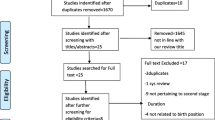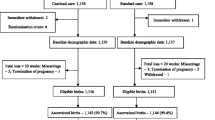Abstract
Background
Medical staff, especially those working in the Department of Gynecology and Obstetrics, have been considered to mostly influence pregnant women on the decision making of delivery mode.
Objective
To investigate mode of delivery among Chinese female obstetrician-gynecologists, midwives and nurses and to explore reasons why they choose cesarean section (CS) for themselves and their advice on mode of delivery.
Methods
Questionnaires including demographic characteristics, their mode of delivery and the reason as well as their suggestion when consulted by pregnant women were administered to 293 participants.
Results
69.7 % was the overall CS rate and 49.0 % without any medical indications. The main reasons for CS were safety for both fetus and mother, easier and quicker labor, fear of injury to the fetus in vaginal delivery (VD), worrying about various unpredicted risk problems in VD and disbelief of VD skills. Those who had experienced CS were more likely to agree with the maternal request for CS or even gave a suggestion straightly for CS.
Conclusions
There is a high rate of CS among Chinese medical staff working in the Department of Gynecology and Obstetrics. Future efforts to reduce the national CS rate would focus on the delivery practice of medical staff, modification of national policies including the one-child policy and promotion of VD skills.
Similar content being viewed by others
References
Lumbiganon P, Laopaiboon M, Gülmezoglu AM et al (2010) Method of delivery and pregnancy outcomes in Asia: the WHO global survey on maternal and perinatal health 2007–08. Lancet 375:490–499
Xinhua H (2003) Thought of cesarean section. Chin. J of Pract Obstet Gynecol 19:385
Hong Y (2011) The cesarean section rate in Shenyang is far beyond the tipping point. Health News 3:31
McGurgan P, Coulter-Smith S, O’ Donovan PJ (2001) A national confidential survey of obstetrician’s personal preferences regarding mode of delivery. Eur J Obstet Gynecol Reprod Bio 97:17–19
Lehmann S, Børdahl PE, Rasmussen SA, Irgens LM (2007) Norwegian midwives and doctors have increased cesarean section rates. Acta Obstet Gynecol Scand 86:1087–1089
Hemminki E, Klemetti R, Gissler M (2009) Cesarean section rates among health professionals in Finland, 1990–2006. Acta Obstet Gynecol Scand 88:1138–1144
Mungrue K, Nixon C, David Y et al (2010) Trinidadian women’s knowledge, perceptions, and preferences regarding cesarean section: how do they make choices? Int J Women’s Health 2:387–391
Lin HC, Xirasagar S, Tung YC (2006) Impact of a cultural belief about ghost month on delivery mode in Taiwan. J Epidemiol Community Health I(60):522–526
Carver RH, Nash JG (2005) Doing data analysis with SPSS version 12.0. Thomson/Brooks/Cole, Belmont, CA
Jacquemyn Y, Ahankour F, Martens G (2003) Flemish obstetricians’ personal preference regarding mode of delivery and attitude towards caesarean section on demand. Eur J Obstet Gynecol Reprod Biol 111:164–166
Groom KM, Paterson-Brown S, Fisk NM (2002) Temporal and geographical variation in UK obstetricians’ personal preference regarding mode of delivery. Eur J Obstet Gynecol Reprod Biol 100:185–188
Land R, Parry E, Rane A, Wilson D (2001) Personal preferences of obstetricians towards childbirth. Aust N Z J Obstet Gynaecol 41:249–252
Monari F, Di Mario S, Facchinetti F, Basevi V (2008) Obstetricians’ and midwives’ attitudes toward cesarean section. Birth 35:129–135
Tang S, Xiaoyan L, Zhuochun W (2006) Rising cesarean delivery rate in primiparous women in urban China: evidence from three nationwide household surveys. Am J Obstet Gynecol 195:1527–1532
Klemetti R, Che X, Gao Y et al (2010) Cesarean section delivery among primiparous women in rural China: an emerging epidemic. Am J Obstet Gynecol 202:e1–e6
Weaver JJ, Statham H, Richards M (2007) Are there “unnecessary” cesarean sections? Perceptions of women and obstetricians about cesarean sections for nonclinical indications. Birth 34:32–41
Fuglenes D, Oian P, Kristiansen IS (2009) Obstetricians’ choice of caesarean delivery in ambiguous cases: is it influenced by risk attitude or fear of complaints and litigation? Am J Obstet Gyncol 200:48
Savage W (2007) The rising caesarean section rate: a loss of obstetric skill? J Obstet Gynaecol 27:339–346
Waldenstrom U, Hildingsson I, Rubertsson C, Radestad I (2004) A negative birth experience: prevalence and risk factors in a national sample. Birth 31:17–27
Walker R, Turnbull D, Wilkinson C (2004) Increasing cesarean section rates: exploring the role of culture in an Australian community. Birth 31:117–124
Lamb F, Pasquier JC (2010) Cesarean delivery by maternal request: surveys of obstetricians. Birth 37:178–179
Tschudin S, Alder J, Hendriksen S et al (2009) Previous birth experience and birth anxiety: predictors of caesarean section on demand? J Psychosom Obstet Gynaecol 30:175–180
Gamble JA, Health M, Creedy DK (2000) Women’s request for a cesarean section: a critique of the literature. Birth 27:256–263
Bergholt T, Østberg B, Legarth J, Weber T (2004) Danish obstetricians’ personal preference and general attitude to elective cesarean section on maternal request: a nation-wide postal survey. Acta Obstet Gynecol Scand 83:262–266
Potter J, Berquo’ E, Perpe’tuo H et al (2001) Unwanted cesarean sections among public and private patients in Brazil: prospective study. BMJ 323:1155–1158
Acknowledgments
We would like to thank Dr. Jie Hu, an associate professor of University of North Carolina at Greensboro School of Nursing, USA, for her kind and professional assistance with the manuscript. We are especially grateful to all who participated in this study. This study could not have been possible without their assistance.
Conflict of interest
None.
Author information
Authors and Affiliations
Corresponding author
Rights and permissions
About this article
Cite this article
Ouyang, Y.Q., Zhang, Q. A study on personal mode of delivery among Chinese obstetrician-gynecologists, midwives and nurses. Arch Gynecol Obstet 287, 37–41 (2013). https://doi.org/10.1007/s00404-012-2517-x
Received:
Accepted:
Published:
Issue Date:
DOI: https://doi.org/10.1007/s00404-012-2517-x




